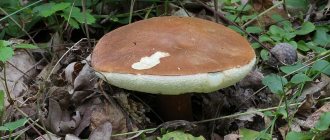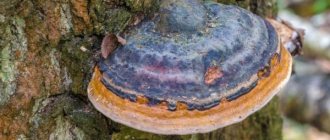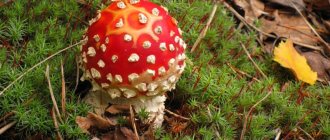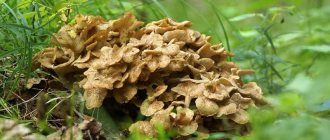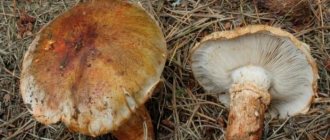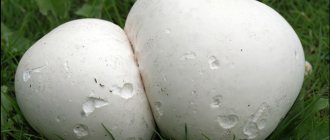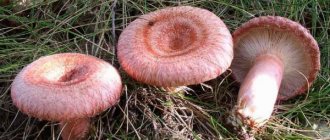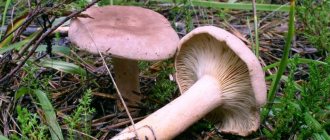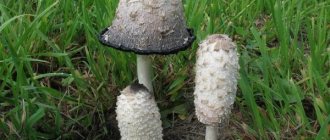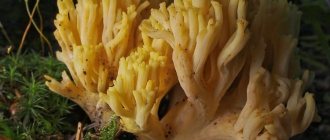Chanterelle mushrooms grow in coniferous and mixed forests. More than 60 species of this mushroom are known. Chanterelles are suitable not only for eating - they are also in demand in the field of traditional medicine. It is impossible to find mushrooms spoiled by parasites in the forests: chanterelles contain chitinmannose, a substance that paralyzes worms and dissolves their eggs.
Places of growth
The chanterelle mushroom is edible and has about 60 varieties. Their peculiarity is a bright, rich color and a cap that is almost completely fused with the stem.
The main habitats are mixed and coniferous forests of the temperate zone. Chanterelles are found both in Kuban and Siberia.
As a rule, they grow in large groups, so you can easily collect so many of them that there will be enough for a whole year of pickles, marinades or roasts.
Reference! These mushrooms are found almost all over the planet - in Europe, Asia, America and Africa. They are loved by gourmets all over the world.
False doubles
The false chanterelle is the most common counterpart to the yellow one. It belongs to the conditionally edible mushrooms, but is extremely undesirable for consumption due to possible severe upset of the digestive system. Look at the following photo for comparison. The difference between false and real chanterelles is obvious.
The inedible mushroom can be distinguished by its orange color and the shape of its cap. In the false chanterelle, its edges form a circle, which is curved under the hymenophore. And the top of the cap is slightly raised, with a cone-shaped seal, like a toadstool, which differs from the concave shape of its edible counterpart.
False fox
Yellow hedgehog is also edible and is often confused with chanterelle. If you look at the photo, you will notice three main differences. The leg is thicker and widens downwards. The color of the cap is pale, milky yellow, as if faded. And the hymenophore has no folds at all. Instead of them there are small soft spikes of milky color.
Yellow hedgehog
Red talkers can also be confused with chanterelles, which is undesirable, because their food processing methods are different. Their features are visible in the photo. The cap is reddish-brown, dry, thin, the edges are smooth and not rounded. The cut flesh is white, and the hymenophore plates are thin and almost invisible.
Talker
Dangerous twins
Poisonous false chanterelle, Hygrophoropsis aurantiaca. Similar in color, place of growth, hymenophore. Fruits on stumps, fallen trees and tree litter. The color of the cap is pinkish-beige, dark yellow with wormholes. The hymenophore is like a sponge.
Hygrophoropsis aurantiaca
Olive omphalot, Omphalotus olearius. Similar in fruit color, smell and place of growth. Settles on wood dust in tropical climates. It has a darker colored cap than the chanterelle. The pulp is brittle and emits a very unpleasant odor.
Omphalotus olearius
ATTENTION! If there are cockerels of different colors in your region, you should also become familiar with their counterparts. This list, as usual for yellow chanterelles, is not exhaustive.
Time and place of collecting chanterelles
Mushrooms bear fruit in two periods - in June and from August to October. Sometimes in a very warm spring they can appear in May.
You need to look under pines and fir trees, oaks or beeches. It is with these tree species that the mycelium of chanterelles forms the best symbiosis. Such mushrooms do not like dark places; you need to look for them along the edges and clearings.
If you are lucky enough to come across a bright red cap, you should take a close look at the forest floor - chanterelles never grow alone. They form large families, so that several buckets can be carried from one clearing.
Growing at home and in the country
This useful product can be cultivated at home. The feasibility of the lesson depends on the scale of the idea. In some cases, it becomes a profitable enterprise, since the price of chanterelles on the market is quite high. And they can be produced in huge quantities if there is an area with pine trees or fir trees. Mushrooms are grown in several ways.
For this we use:
- purchased mycelium;
- spore tincture;
- dug mycelium;
- top layer of soil with mycelium.
For planting, you need a plot with a tree of the same species under which forest mushrooms were collected or soil (fir tree, spruce or oak).
The mycorrhiza of chanterelles, from which the colony emerges, requires symbiosis with the roots of the tree. A guaranteed result of mushroom germination is provided by mycelium collected in the forest.
We will describe this method in more detail. To implement the event, it will take: a year to prepare the turf, and another one for mushrooms to appear.
As soon as purple threads of mycelium with a greenish tint break through the ground, the clearing will begin to “turn yellow” at an accelerated pace.
The technology is simple:
- They go to the forest and find a place where chanterelles grow. This is best done in May or late summer.
- They look for a healthy tree without signs of disease and dig up a couple of sods of earth 40x40 cm wide and 15 cm high near it.
- Transported carefully. Divide the soil into 9 parts and place it in a box, leaving access to oxygen. Store the material in a cool, dark place, without watering. Subsequent breeding begins in the summer (June) of next year.
- Immediately before planting, improve the soil by watering it once a week. They also disinfect the parasites of the tree itself. The soil around the trunk is soaked with a decoction of oak bark.
- Nine holes 20 cm deep are dug next to the symbiote tree and spore soil is compacted into them. Water generously. Cover the planting site with moss, leaves or coniferous litter. The area is periodically moistened. The first shoots will appear in a year.
ATTENTION! Chanterelles grow only in natural conditions. In greenhouses and basements - no.
Types of chanterelles
Most varieties of these mushrooms are edible. The most common and familiar to Russians are the trumpet and common chanterelle. They even belong to different species and have their own characteristics.
Common chanterelle
It is also called Cantarellus yellow. All mushroom pickers know what chanterelles look like. This is the most familiar type to everyone. This is exactly what grows in most of the Russian Federation, Europe, and North America. It was first described by Carl Linnaeus.
The common fox, or cockerel, is an edible fruiting body. The size of the chanterelle mushroom cap is from 2 to 12 cm. The lower part - the hymenophore - consists of wavy plates, quite rare.
Color ranges from pale yellow to golden orange. The stem, as a rule, is equal in length to the diameter of the cap, narrow at the root, and widens higher up. Thickness from 0.5 cm in young mushrooms, up to 4 cm in adults. The color is less saturated than that of the cap.
The common chanterelle is a mushroom that is not demanding on growing conditions. The first harvests can be harvested as early as May after spring thunderstorms, because Cantarellus only needs one week to grow to the desired size. The second wave of ripening is mid-summer - late autumn.
These mushrooms love both rain and sun. In dry weather they prefer to grow in lowlands and shade, in wet weather - on the edges and hills.
Reference! The best time to harvest is from July to October. However, due to global warming, chanterelles have begun to be found even in December and January.
Like any other mushrooms, the cockerel is capable of accumulating heavy metals and radiation with age. Therefore, it is not worth taking specimens with a cap diameter larger than 9-10 cm. But the chanterelle also has a unique feature - it is not susceptible to insect attacks, since it contains chitinmannose. This substance is toxic to larvae and pathogens. Therefore, the chanterelle has virtually no waste.
This mushroom is listed in the regional Red Books of the Yamalo-Nenets Autonomous Okrug, Khabarovsk Territory, Pskov and Murmansk regions.
For illegal collection, the violator faces a serious fine. Residents of other regions of Russia can collect red-haired beauties without fear.
The presence of minerals and useful components of the fruiting body allows us to speak not only of its unique taste, but also of its healing properties.
Chemical composition:
- vitamins A, B1, B2, C, E;
- amino acids;
- trametonolinic acid;
- trace elements: potassium, calcium, iron, zinc, cobalt, chromium.
Chanterelle has a slightly sour, apricot-like odor. It is great in all forms - fried, salted, pickled. Caviar from chanterelles turns out no worse than from saffron milk caps.
Reference! Thanks to their set of vitamins and microelements, these mushrooms perfectly increase immunity, improve blood counts and have a beneficial effect on the entire functioning of the human body.
Trumpet chanterelle
It is also called funnel-shaped. This is a very popular mushroom in Europe, but here mushroom pickers are not very fond of this variety of chanterelle. Outwardly, it is very similar to the autumn honey fungus, it even has scales. The cap of the tubular variety is cream to light brown in color with an uneven edge. An adult mushroom resembles a funnel, which is why it got its second name. Old specimens are even found with holes in the bottom of the cap.
The hymenophore is folded, extending onto the stalk. The spore-bearing layer is always gray. The leg is exclusively yellow and hollow inside.
Mycological specialists generally do not classify this species as belonging to the genus Chanterelles (Cantharellus), but define them as the Funnelweed (Craterellus). The tubular variety is much smaller than the ordinary one. The diameter of the cap does not exceed 6 cm, and the thickness of the stem is 7-8 mm.
The funnel chanterelle has a much weaker aroma, but the taste when cooked is simply delicious. It can be boiled, fried, salted, pickled. At the same time, it does not lose its taste after heat treatment.
Reference! This species is found everywhere in the European part of Russia, but mushroom pickers do not favor it, mistaking it for being poisonous. But the Finns are ready to pay a lot of money for the trumpet chanterelle – up to 700 rubles per kg. In Sweden it is also a delicacy.
From the history of studying the yellowing chanterelle
In 1821, the yellowing chanterelle was first described in the scientific literature by the Swedish mycologist-taxonomist Elias Magnus Fries.
In the 1st volume of his work - “Systema Mycologicum”, the mushroom was listed under the name Canthrellus lutescens. However, in 1838, the scientist moved it to the genus Craterellus, which includes fungi with funnel-shaped fruiting bodies. Based on a number of characteristics, the genera Cantharellus (Chanterelle) and Craterellus (Craterellus) have always been recognized as closely related. Because of this, attempts have been made repeatedly to combine them, giving rise to a long synonymous series in the names of mushrooms of the Chanterelle family as such, and the yellow chanterelle in particular. The debate was resolved by fungal DNA studies, which showed that each genus is monophyletic (each has its own ancestor) and therefore they are likely to remain separate.
Today, according to Index Fungorum, a database of scientific names of mushrooms, yellow chanterelles belong to the genus Craterellus, although many resources still call them Cantharellus lutescens.
Characteristic
Chanterelle is a third category agaric mushroom. It has high taste and a lot of useful microelements and vitamins. Chanterelle is the champion among mushrooms in terms of carotene content.
There are edible and inedible varieties. The fruiting bodies used in cooking have a pleasant mushroom aroma. Inedible ones tend to smell like vinegar or fish.
Chanterelle mushrooms have medicinal properties. Our ancestors ate them even raw to get rid of many diseases.
Mushroom dimensions
Depending on the type, they differ quite significantly. The largest specimens grow in the cockerel, the smallest in the tubular one.
hat
In young mushrooms, the upper part is slightly convex, but with age it becomes concave and funnel-shaped. The edges are sinuous and wavy.
The spore-bearing layer is lamellar, passing onto the stalk. The gills of the hymenophore are sparse, 1 cm less than 10. Some of the plates grow as if from nowhere and end “nowhere,” that is, they are not attached to either the cap or the leg.
The color of the surface part ranges from pale yellow to golden-red in the common chanterelle. And from cream to light brown in the tubular one. The film is sticky and does not separate from the cap.
Pulp
The fruiting body of chanterelles is dense and white. The ordinary one has fibrous and fleshy pulp. It turns slightly red when pressed. The aroma of fresh mushrooms is fruity, and the taste is slightly sour.
Leg
In most species, the stem is hollow or tubular and slightly paler than the cap. The length depends on the diameter of the cap - they are approximately the same. The thickness is usually from 0.5 to 4 cm.
Reference! Large specimens of common chanterelles are best cut, but tubular ones can be cooked whole.
Description
The yellowish or yellowish chanterelle has a structure characteristic of chanterelles: the cap goes into the leg without clear boundaries. These are generally small mushrooms, located in groups or clumps.
hat
Chanterelle yellowing.
The yellow chanterelle's cap usually looks like a deep funnel, the edges of which are turned downwards. The edges are carved, thin and brittle.
The color of the cap is brownish-yellow, darker than that of real chanterelles. The size of the cap is small - up to 5 cm in diameter. The surface is dry.
Spore-bearing layer
The hymenophore of the yellowing chanterelle in young specimens is almost smooth, subsequently slightly wrinkles and acquires characteristic folding. At first it is yellow in color, but in mature mushrooms it begins to turn gray.
Leg
The chanterelle is yellowish.
The legs of yellowing chanterelles are long (in relation to the overall size of the mushroom), can reach 10 cm, quite thin - up to 1 cm. The shape of the leg is cylindrical, narrowed downwards, and often has a bend.
Contains a cavity inside. The color of the leg is yellow, merging with the hymenophore. May have longitudinal folds.
Pulp
The pulp of yellowish chanterelles has a slightly “rubbery” consistency. She is hard but fragile. Does not have a special aroma or taste.
Spore powder
The spores of the yellowing chanterelle are smooth, large and ellipse-shaped. They generally form a beige-orange spore powder.
The use of chanterelles in cooking and medicine
The uniqueness of cantarellus is that you can cook any dish with it. Chanterelles have proven themselves well both as an independent dish and as a component of complex recipes.
They are incredibly tasty fried with sour cream and a side dish of vegetables. It is often used as a sauce for spaghetti in Italian cuisine.
Pairs perfectly with any meat - chicken, pork, beef and even fish. Potatoes, rice, carrots, pasta, eggs, cereals, legumes and all types of cabbage are suitable as a side dish.
Chanterelles can be stewed, pickled, dried, frozen. Dried mushrooms are made into a powder that is added as a flavoring to meat or vegetable dishes. Gourmets even make jam from chanterelles.
Reference! These mushrooms should not be consumed by people with digestive problems. And for everyone else, you don’t need to eat at night, because they weigh down your stomach.
Due to their composition, these mushrooms have long been used as medicine. Due to the presence of the substance chitinmannose, which is rarely found in nature, chanterelles work well as an anthelmintic. This component of mushrooms easily gets rid of any types of parasites, since it is poisonous to larvae and worms.
Ergosterol in the fruiting bodies stimulates the production of enzymes in the human body. Therefore, they are used in the treatment of liver diseases and diabetes. Trametolinic acid is destructive to the hepatitis C virus. Chanterelles have proven themselves well in getting rid of sore throats, tuberculosis, in the prevention of heart rhythm disorders, and strengthening the immune system.
Dried mushroom powder or alcohol extract (not higher than 38 degrees) is used as a medicine.
Despite all the benefits, there are also contraindications to the use of these mushrooms:
- pregnancy and breastfeeding;
- children under 3 years of age;
- individual intolerance.
Reference! Chanterelles were used for medicinal purposes in ancient Rome, and our ancestors ate them raw for various ailments.
Calorie content of chanterelles
These mushrooms contain quite a lot of protein, so their energy and nutritional value is high. 100 g of raw mushrooms contains:
- proteins – 1.5 g;
- fat – 1.1 g;
- carbohydrates – 1.1 g.
Average caloric content – 19 kcal/100 g.
To summarize
Finally, I would like to discuss growing chanterelle mushrooms. This must be done in a specially equipped room where temperature, humidity, lighting, and so on will be regulated. First, you should buy soil with fertilizers, then mycelium, which should be grown according to the instructions. White chanterelle is often used for cultivation. She's the easiest to work with. But white chanterelles are the most common.
False chanterelles
Don't forget what false chanterelles look like, as this will save you and your family from poisoning. Remember that for children under 8-10 years of age, it is advisable to exclude all types of mushrooms. Also, you should not eat them during pregnancy and breastfeeding. On your first trip, be sure to take a mushroom picker and a text description or photo of the chanterelle with you. In the comments below the article you can ask all your questions. Have a nice trip!
Interesting facts about chanterelles
- In the forest, these mushrooms grow in the form of so-called “witch’s rings.”
- They contain an antibiotic that kills Koch's bacillus, the cause of tuberculosis.
- When heated, all the vitamins contained in them are destroyed.
- Chanterelle contains more vitamin A than carrots. And in China, they are used to treat night blindness and visual impairment.
- In Africa, cosmetic masks, creams and lotions are prepared from chanterelles. In the USA, a chef competition is held annually to find the most original dish made from these mushrooms.
- The largest varieties grow in California. Their weight reaches 500 grams.
Beneficial properties of chanterelle mushrooms
The yellow chanterelle mushroom has a set of useful substances that are important for humans. These are microelements - zinc, copper; and vitamins. The content of vitamin PP is high, and vitamin B1 in chanterelle is no less than in yeast.
The substance quinomannose found in chanterelle makes the mushroom useful as a means to combat helminths (worms).
And, of course, the most important beneficial property of chanterelles for most is their excellent taste and aroma. And also the fact that during processing they do not lose their color and pleasant smell, allowing us to decorate our table.
The beneficial properties of chanterelle mushrooms are being studied. Perhaps scientists will isolate substances from the mushroom that can help with cancer.
Edible and inedible chanterelle: what is the difference?
Unlike edible mushrooms, harmful mushrooms often grow not as a family, but alone. They prefer old fallen trees or rotting stumps. By the shape and color of the caps, without even holding them in your hand, you can distinguish an edible chanterelle from a false one (people call them talkers).
False chanterelle
A real mushroom has a rich, but not flashy color. False - a bright, saturated, fiery color with an admixture of brown. The color of the chanterelle's cap is uniform, while the edges of the "talker" are lighter than the middle.
Edible mushrooms have an uneven, wavy edge. While the cap of the false ones tends to have an ideally even side, slightly rounded down. The flesh of the “talker” is yellow and does not change color when pressed. The smell is unpleasant, pungent.
The most striking distinguishing feature is the thin leg. In the chanterelle it is dense, smooth, yellow in color, expanding upward and connected to the cap. The inedible double has a leg of the same diameter along its entire length, reddish in color and clearly separated from the cap.
Reference!! Chanterelles, like other mushrooms, cannot be collected near cities, roads or industrial enterprises.
Yellow chanterelle, or common chanterelle. Description of the mushroom
Yellow chanterelle is a mushroom of the Chanterelle family of the order Aphyllophoraceae. It cannot, therefore, be classified as a lamellar mushroom (they are agaric). I probably won’t go into the jungle of mycology (the science of mushrooms). But, taking a closer look at the mushroom, obvious external signs of difference from lamellar ones can be easily seen. There are no real plates in the hymenophore of chanterelles. And there are forked folds, with a rounded edge. They descend in a kind of fan onto the stem of the mushroom, which does not happen with lamellar mushrooms.
Yellow chanterelle, or real
The fruiting body of the mushroom is very peculiar. The cap is firmly fused with the stem; they can be separated only by cutting it (in agaric it breaks off easily). The shape of the cap is funnel-shaped, but this funnel is usually irregular. The edge of the cap is very uneven. And the small, recently appeared mushroom is round, flat, and similar in size and shape to a coin.
The color of the mushrooms is bright yellow. Like the ears of a lurking red fox, these mushrooms stick out from the forest floor, between lichens and lingonberry bushes. This is probably why they are named that way.
The chanterelle does not have plates, but forked folds
The leg of the yellow chanterelle (real, ordinary) is never hollow. It is filled with white fibers. By the way, chanterelles have only a yellow surface layer; they are white inside. The fibers run along the fruiting body, so even cutting the mushroom is easier not across them, but along it.
The yellow color probably helps the mushroom avoid overheating by the sun's rays. After all, the yellow chanterelle mushroom grows, albeit in the forest, but in areas where grass cover is rare or absent altogether. But this sign makes the chanterelle more noticeable to mushroom pickers.
An aged mushroom, up to 10 - 12 centimeters in diameter and about ten in height, may no longer be yellow, but orange. But it is better not to take such a mushroom, as well as any other overripe mushrooms.
The chanterelle is not affected by fungal “worms” (larvae of fungus gnats and flies). This is another important sign for a mushroom picker. It has been established that it contains the substance quinomannose, which suppresses the development of these larvae and kills them. Similarly, chanterelle can affect worms - helminths.
After picking a chanterelle, break it lengthwise and smell it. The subtle pleasant aroma of the mushroom is another characteristic feature. Once you remember it, you will never confuse a chanterelle with another mushroom.
The mushroom grows very slowly. It takes two or even three weeks for the small, penny-sized fruiting body that appears to become an adult, mature mushroom.
Some tips for storing chanterelles
In order not to lose the excellent taste, aroma and beneficial properties of these mushrooms, you need to know the rules for their processing:
- Despite the fact that chanterelles keep their shape well and are easy to transport, they cannot be stored for a long time. Maximum 1-2 days in the refrigerator and only in open glass or enamel containers. In plastic bags, mushrooms instantly get wet and become moldy.
- During heat treatment, all vitamins in chanterelles are completely destroyed. Therefore, for medicinal purposes, it is better to dry them at a temperature not exceeding 45°C. The prepared raw materials are ground into powder and used as a seasoning or in traditional medicine recipes.
- When thawing after freezing, chanterelles may become bitter. It is better not to freeze them. But if you still have to do this, then you first need to boil the mushrooms in milk for 15-20 minutes or fry them in butter. Then after freezing they will not change their light fruity taste.
- Chanterelles store well when fried. To do this, heat the vegetable oil well in a frying pan. Washed and dried mushrooms are fried for 30 minutes with the addition of salt and bay leaf. The chanterelles can be boiled first. The finished mushrooms are transferred to sterilized jars and hermetically sealed. Then they need to be wrapped tightly and left to cool completely. Shelf life: 6 months in the refrigerator.
- You can salt the chanterelles after preliminary boiling for 15-20 minutes. Then the mushrooms are washed, placed in an enamel pan, sprinkled with salt in layers (2 tbsp per 1 kg of chanterelles). Oppression is placed on top. After a month, the mushrooms can be transferred from the brine to jars. Salted chanterelles should be stored in the refrigerator.
- Pickled chanterelles cook faster. The mushrooms are boiled, placed in sterilized jars and poured with boiling marinade (for 1 liter of water, 3 tablespoons of salt, ½ tablespoon of sugar, 2-3 cloves of garlic and 1 tablespoon of 9% vinegar). Chanterelles prepared in this way are stored for up to 1 year.
Why are chanterelles not wormy?
Worminess in chanterelles is a very rare occurrence, thanks to a special substance contained in these mushrooms. We are talking about D-mannose or quinomannose, a natural monosaccharide.
Hinomannose repels various insects, parasites, and helminths. Moreover, the substance acts on both adult individuals and their larvae. As soon as an insect comes into contact with quinomannose, the monosaccharide begins to have a paralyzing effect on it.
Interesting fact : D-mannose is destroyed at temperatures of +50℃ and above, as well as upon contact with acids and salts.
Still there are some exceptions. For example, wireworm larvae and black beetle larvae are not afraid of quinomannose, so they can sometimes be found in chanterelles. Their bodies are covered with a denser shell compared to other worms, which serves as protection against the monosaccharide.
